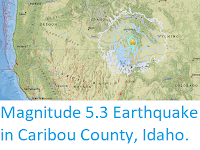A man has died in an avalanche in Swan Valley to the east of Palisades Reservoir, in Bonneville County, Idaho, on Tuesday 20 February 2018. Troy Leishman, 47, from Idaho Falls was snowmobiling with a group of friends when he was hit by the avalanche slightly after 4.00 pm local time. He was quickly located and dug out by his companions, but died at the scene of the incident.
The approximate location of the 20 February 2018 Swan Valley avalanche. Google Maps.
Avalanches are caused by the mechanical failure of snowpacks;
essentially when the weight of the snow above a certain point exceeds
the carrying capacity of the snow at that point to support its weight.
This can happen for two reasons, because more snow falls upslope,
causing the weight to rise, or because snow begins to melt downslope,
causing the carrying capacity to fall. Avalanches may also be triggered
by other events, such as Earthquakes or rockfalls. Contrary to what is
often seen in films and on television, avalanches are not usually
triggered by loud noises. Because snow forms layers, with each layer
typically occurring due to a different snowfall, and having different
physical properties, multiple avalanches can occur at the same spot,
with the failure of a weaker layer losing to the loss of the snow above
it, but other layers below left in place - to potentially fail later.
Diagrammatic representation of an avalanche, showing how layering of snow contributes to these events. Expedition Earth.
Northwestern North America have seen a number of avalanche related incidents this winter,
largely due to high levels of snowfall. This is, in turn caused by
warmer conditions over the Pacific, which leads to higher rates of
evaporation over the ocean, and therefore higher rates of precipitation
over North America, which falls as snow in cooler upland regions. There are further concerns that as the climate warms in the coming months, the thawing of this snow will lead to further dangerous avalanches.
See also...
Follow Sciency Thoughts on Facebook.







